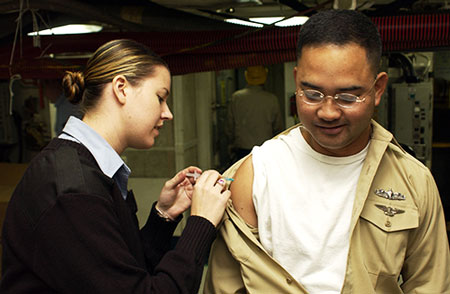*This course has been retired. There is no replacement course at this time. Please click here to view the current ATrain course listings.
Each year, experts from CDC, World Health Organization (WHO), and other institutions study virus samples collected from around the world to identify the influenza viruses that are the most likely to cause illness during the upcoming flu season. This information is used to create a vaccine.
Because flu viruses are constantly changing, it is not possible to predict with certainty which types of viruses will predominate during a given season. Flu viruses can change from one season to the next and can even change within the course of one flu season. Experts must pick which viruses to include in the vaccine many months in advance in order for vaccine to be produced and delivered on time. Because of these factors, there is always the possibility of a less-than-optimal match between circulating viruses and the viruses in the vaccine.
Most influenza vaccines available in the United States for the 2020–21 season will be quadrivalent vaccines, with the exception of MF59-adjuvanted IIV (aIIV), which is expected to be available in both trivalent (aIIV3, Fluad) and quadrivalent (aIIV4, Fluad Quadrivalent) formulations.
For the 2020–21 season, U.S. egg-based influenza vaccines (i.e., vaccines other than ccIIV4 and RIV4) will contain HA derived from:
- an influenza A/Guangdong-Maonan/SWL1536/2019 (H1N1)pdm09-like virus;
- an influenza A/Hong Kong/2671/2019 (H3N2)-like virus;
- an influenza B/Washington/02/2019 (Victoria lineage)-like virus; and
- for quadrivalent vaccines only, an influenza B/Phuket/3073/2013 (Yamagata lineage)-like virus. (Grohskopf et al., 2020)
For the 2020–21 season, U.S. cell culture–based inactivated (ccIIV4) and recombinant (RIV4) influenza vaccines will contain HA derived from:
- an influenza A/Hawaii/70/2019 (H1N1)pdm09-like virus;
- an influenza A/Hong Kong/45/2019 (H3N2)-like virus;
- an influenza B/Washington/02/2019 (Victoria lineage)-like virus; and
- an influenza B/Phuket/3073/2013 (Yamagata lineage)-like virus. (Grohskopf et al., 2020)
The 2019–2020) U.S. quadrivalent vaccines contain the same three antigens listed above and an additional influenza B virus component, a B/Phuket/3073/2013–like virus (Yamagata lineage). Compared with the 2018–2019 season, the composition for 2019–2020 includes updates in the influenza A(H1N1) and influenza A(H3N2) components of the vaccine (Grohskopf et al., 2019).
The 2020–21 composition reflects updates in the influenza A(H1N1)pdm09, influenza A(H3N2), and influenza B (Victoria lineage) components (Grohskopf et al., 2020).
For the 2020–2021 season, routine annual influenza vaccination of all people aged ≥6 months without contraindications continues to be recommended. A licensed, recommended, and age-appropriate vaccine should be used (Grohskopf et al., 2020).
A quadrivalent live attenuated influenza nasal spray vaccine (LAIV4) made with attenuated (weakened) live flu viruses, is approved for use in people 2 years through 49 years of age. This vaccine is not recommended for use in pregnancy or for people with some specific medical conditions (CDC, 2019b).
People with egg allergies can receive any licensed, recommended, age-appropriate influenza vaccine that is otherwise appropriate. People who have a history of severe egg allergy (those who have had any symptom other than hives after exposure to egg) should be vaccinated in a medical setting, and supervised by a healthcare provider who is able to recognize and manage severe allergic reactions (Grohskopf et al., 2020).
Balancing considerations regarding the unpredictability of timing of onset of the influenza season and concerns that vaccine-induced immunity might wane over the course of a season, it is recommended that vaccination should be offered by the end of October. Children aged 6 months through 8 years who require 2 doses should receive their first dose as soon as possible after vaccine becomes available, to allow the second dose (which must be administered ≥4 weeks later) to be received by the end of October (Grohskopf et al., 2020).
Community vaccination programs, however, should balance maximizing likelihood of persistence of vaccine-induced protection through the season with avoiding missed opportunities to vaccinate or vaccinating after onset of influenza circulation occurs. No recommendation is made for revaccination later in the season of persons who have already been fully vaccinated (ie, providing a booster dose) (Grohskopf et al., 2020).
For a table of approved influenza vaccines for the 2020–21 season, click here.
Giving an Influenza Vaccination via Needle

Source: United States Navy. Public domain.
